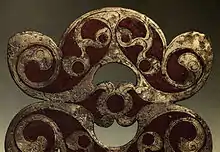Museum of Archaeology and Anthropology, University of Cambridge
The Museum of Archaeology and Anthropology, also known as MAA, at the University of Cambridge houses the University's collections of local antiquities, together with archaeological and ethnographic artefacts from around the world. The museum is located on the University's Downing Site, on the corner of Downing Street and Tennis Court Road. In 2013 it reopened following a major refurbishment of the exhibition galleries, with a new public entrance directly on to Downing Street.[2]
 Museum of Archeology and Anthropology, Cambridge | |

| |
| Location | Cambridge |
|---|---|
| Coordinates | 52°12′09.63″N 0°07′15.05″E |
| Type | University Museum |
| Collections | local antiquities, together with archaeological and ethnographic artefacts from around the world |
| Visitors | 76,669 (2019)[1] |
| Director | Professor Nicholas Thomas |
| Owner | University of Cambridge |
| University of Cambridge Museums | |
| Part of a series on the |
| Anthropology of art, media, music, dance and film |
|---|
 |
| Social and cultural anthropology |
The museum is part of the University of Cambridge Museums consortium.[3]
History
Founded in 1884 as the University's Museum of General and Local Archaeology, the museum initial collections included local antiquities collected by the Cambridge Antiquarian Society and artefacts from Polynesia donated by Alfred Maudslay and Sir Arthur Gordon. Anatole von Hügel, the museum's first curator donated his own collection of artefacts from the South Pacific. More material was collected by the 1898 Cambridge anthropological expedition to the Torres Strait under Alfred Haddon and W. H. R. Rivers. Haddon and Rivers would encourage their Cambridge students — including Alfred Radcliffe-Brown, John Layard and Gregory Bateson — to continue to collect for the museum in their ethnographic fieldwork.
Von Hügel set in motion a move to larger, specially built, premises: in 1913 the museum moved to its present location in Downing Street, although the new galleries were not fully installed until after World War I. Various depositions and donations of eighteenth-century collections — including material collected on James Cook's three expeditions — were made to the museum in the 1910s and 1920s.
Von Hügel's successors as curator have been Louis Colville Gray Clarke (from 1922 to 1937), Thomas Paterson (from 1937 to 1948), Geoffrey Bushnell (from 1948 to 1970), Peter Gathercole (from 1970 to 1981), Prof. David Phillipson (1981 to 2006), and the 2006-present Director, Prof. Nicholas Thomas.
The museum's current displays are arranged on three floors:
- Ground floor: The Clarke Hall: Archaeology of Cambridge and the Li Ka Shing Gallery (Temporary Exhibitions)
- First floor: The Maudslay Hall: Anthropology
- Second floor: Andrews Gallery: World Archaeology
The museum building, which is Grade II listed, incorporates the central section of Inigo Jones's choir screen from Winchester Cathedral.[4]
Gweagal Spears
In 1770, after returning to England from their voyage in the South Pacific Ocean, Captain James Cook and botanist Joseph Banks brought with them, along with a large collection of flora and fauna, many cultural artefacts. These included a collection of roughly fifty Australian Aboriginal spears that belonged to the Gweagal people. The spears were given to Cook's patron John Montagu, 4th Earl of Sandwich, who then gave them, to his alma mater Trinity College, and four are still in existence. The spears are among the few remaining artefacts that can be traced back to Cook's first voyage. Although the Gweagal Spears remain in the ownership of Trinity College, they are on display at the Museum.[5][6][7]
Gallery
 Haida totem pole
Haida totem pole Haida totem pole (detail)
Haida totem pole (detail) Ornamental bronze (Santon, Norfolk)
Ornamental bronze (Santon, Norfolk).jpg.webp) Bronze plaque (Santon, Norfolk) (detail)
Bronze plaque (Santon, Norfolk) (detail)
References
- "ALVA - Association of Leading Visitor Attractions". www.alva.org.uk. Retrieved 17 November 2020.
- "Archived copy". Archived from the original on 20 May 2014. Retrieved 20 May 2014.CS1 maint: archived copy as title (link)
- McPhee, Jo (6 August 2013). "Our Museums". www.cam.ac.uk.
- Historic England. "Geological Museum, Law School and University Museum of Archaeology and Ethnology (Grade II) (1120793)". National Heritage List for England. Retrieved 2 June 2019.
- "Once were warriors". The Sydney Morning Herald. 11 November 2002. Retrieved 3 May 2019.
- Daley, Paul (24 September 2016). "The Gweagal shield and the fight to change the British Museum's attitude to seized artefacts". The Guardian. Retrieved 3 May 2019.
- McKenna, Mark (2018). Moment of Truth: History and Australia's Future. Quarterly Essay 69. Black. ISBN 978-1-743-82037-7.
Further reading
- V. Ebin and D.A. Swallow, “The Proper Study of Mankind…”: great anthropological collections in Cambridge. University of Cambridge Museum of Archaeology and Anthropology, 1984
- A. Herle and J. Philp, Torres Strait Islanders: an exhibition marking the centenary of the 1898 Cambridge Anthropological Expedition to the Torres Strait. University of Cambridge Museum of Archaeology and Anthropology, 1998.
- J. Tanner, From Pacific Shores: eighteenth-century ethnographic collections at Cambridge. University of Cambridge Museum of Archaeology and Anthropology, 1999.
- Robin Boast, S. Guha and A. Herle Collecting Sights: the Photographic Collections of the Museum of Archaeology & Anthropology, 1850—1970. Cambridge: Museum of Archaeology and Anthropology, Cambridge University Press, 2001
- Haidy Geismar and Anita Herle: Moving images.John Layard, fieldwork and photography on Malakula since 1914, with contributions by Kirk Huffman and John Layard; Crawford House Publishing Australia, Adelaide in association with University of Cambridge Museum of Archaeology & Anthropology, Cambridge 2009 ISBN 978-1-86333-319-1
External links
| Wikimedia Commons has media related to Museum of Archaeology and Anthropology, University of Cambridge. |
